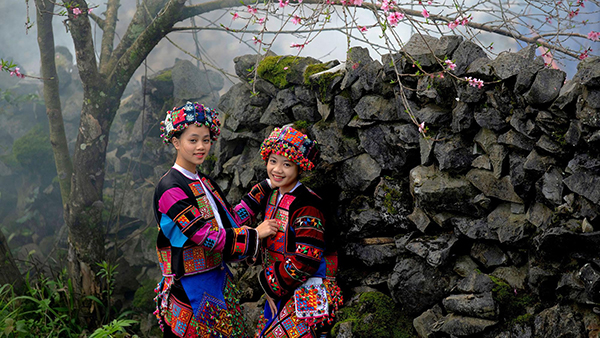The Yi or Nuosu people (Nuosu: ꆈꌠ, [nɔ̄sū]; see also § Names and subgroups) are an ethnic group in southern China. Numbering nine million people, they are the seventh largest of the 55 ethnic minority groups recognized by the Chinese government. They live primarily in rural areas of Sichuan, Yunnan, Guizhou, and Guangxi, usually in mountainous regions. The Liangshan Yi Autonomous Prefecture is home to the largest population of Yi people within China, with two million Yi people in the region. In neighbouring Vietnam, as of 2019, there are 4,827 Lô Lô people (a subgroup of the Yi) living in the Hà Giang, Cao Bằng, and Lào Cai provinces, in the country’s north.
The Yi speak various Loloish languages, closely related to Burmese. The prestige variety is Nuosu, which is written in the Yi script.
Location
Of the more than 9 million Yi people, over 4.5 million live in Yunnan Province, 2.5 million live in southern Sichuan Province and 1 million live in the northwest corner of Guizhou Province. Nearly all the Yi live in mountainous areas, often carving out their existence on the sides of steep mountain slopes far from the cities of China.
The altitudinal differences of the Yi areas directly affect the climate and precipitation of these areas. These striking differences are the basis of the old saying that “The weather is different a few miles away” in the Yi area. Yi populations in different areas are very different from one another, making their living in completely different ways
Names and subgroups
Although different groups of Yi refer to themselves in different ways (including Nisu, Sani, Axi, Lolo, and Acheh) and sometimes speak mutually unintelligible languages, they have been grouped into a single ethnicity by the Chinese and the various local appellations can be classified into three groups:
Ni (ꆀ). The appellations of Nuosu, Nasu, Nesu, Nisu and other similar names are considered derivatives of the original autonym Nip (ꆀ) appended with the suffix -su, indicating ‘people’. The name Sani is also a variety of this group. Further, it is widely believed that the Chinese name Yí (both 夷 and 彝) were derived from Ni.
Lolo. The appellations of Lolo, Lolopu, etc. are related to the Yi people’s worship of the tiger, as lo in their dialects means ‘tiger’. Lo is also the basis for the Chinese exonym Luóluó (猓猓, 倮倮 or 罗罗). The original character (猓), with the “dog radical” (犭) and a guǒ (果) phonetic, was a graphic pejorative, comparable to the Chinese name guǒran (猓然, ‘a long-tailed ape’). Languages reforms in the PRC replaced the character in Luóluó twice—first by Luó (倮), with the “human radical” (亻) and the same phonetic, but that was a graphic variant for luǒ (裸, ‘naked’), and later by Luó (罗, ‘net for catching birds’). Paul K. Benedict noted, “a leading Chinese linguist, has remarked that the name ‘Lolo’ is offensive only when written with the ‘dog’ radical.”
Other. This group includes various other appellations of different groups of Yi. Some of them may be of other ethnic groups but are recognised as Yi by the Chinese. The “Pu” may be relevant to an ancient ethnic group Pu (濮). In the legends of the Northern Yi, the Yi people conquered Pu and its territory in the northeastern part of the modern Liangshan.
Groups listed below are sorted by their broad linguistic classification and the general geographic area where they live. Within each section, larger groups are listed first.
History
Origin myth
According to Yi legend, all life originated in water and water was created by snowmelt, which as it dripped down, created a creature called the Ni. The Ni gave birth to all life. Ni is another name for the Yi people. It is sometimes translated as black because black is a revered color in Yi culture. Yi tradition tells us that their common ancestor was named Apu Dumu ꀉꁌꅋꃅ or ꀉꁌꐧꃅ (Axpu Ddutmu or Axpu Jjutmu). Apu Dumu had three wives, each of whom had two sons. The six sons migrated to the area that is now Zhaotong and spread out in the four directions, creating the Wu, Zha, Nuo, Heng, Bu, and Mo clans. The Yi practiced a lineage system where younger brothers were treated as slaves by their elders, which resulted in a culture of migration where younger brothers constantly left their villages to create their own domains.
Language
The Chinese government recognizes six mutually unintelligible Yi languages, from various branches of the Loloish family:
Northern Yi (Nuosu 诺苏)
Western Yi (Lalo 腊罗)
Central Yi (Lolopo 倮倮泼)
Southern Yi (Nisu 尼苏)
Southeastern Yi (Sani 撒尼)
Eastern Yi (Nasu 纳苏)
Northern Yi is the largest with some two million speakers and is the basis of the literary language. It is an analytic language. There are also ethnically Yi languages of Vietnam which use the Yi script, such as Mantsi.
Many Yi in Yunnan, Guizhou and Guangxi know Standard Chinese and code-switching between Yi and Chinese is common.
Culture
Gender
Descent and inheritance in Yi society was traditionally patrilineal and men were generally considered superior to women. Men practiced polygamy and levirate marriage. Women were excluded from oral genealogies. In certain locales, Yi women still lag behind men in terms of primary education and very few Yi women become educational instructors or political leaders. Yi women noticeably drank and smoked more than Han Chinese women.
Names
The Yi use a son-father patronymic naming system. The last character of the father’s name transfers to become the first character of the son’s name. The last character of the son’s name is then used as the first character of the grandson’s name. A complete Yi name is composed of the clan name, the branch clan name, the father’s name, and the person’s own name (ex. Aho Bbujji Jjiha Lomusse). Aho is the name of a tribe, Bbuji is the name of a clan, Jjiha is the father’s name, and Lomusse is a personal name. The name therefore means Lomusse the son of Jjiha of the Bbujji clan of the Aho tribe. Within the clan he would just be called Lomusse and within the tribe he would be called Jjiha Lomusse. Yi names use the suffixes -sse and -mo to express maleness and femaleness respectively.
This system can also be seen in the names of Nanzhao’s rulers:
Xinuluo
Luosheng
Shengluopi
Piluoge
Geluofeng
Fengjiayi
Yimouxun
Xungequan
Quanfengyou – sought to imitate Chinese practices and only went by Fengyou; broke tradition and named his son Shilong
Shilong
Longshun
Shunhuazhen
This is a tradition closely tied to Tibeto-Burman traditions and suggests that the rulers of Nanzhao were not Tai people.
Religion
Bimoism (Chinese: 毕摩教; pinyin: Bìmójiào, Yi: ꀘꂾ bi mox) is the indigenous religion of the Yi people, the largest ethnic group in Yunnan after the Han Chinese. It takes its name from the bimo, shaman-priests who are also masters of Yi language and scriptures, wearing distinctive black robes and large hats.
Medicine
The Yi are known for the extent of their inter-generational transmission of traditional medicine through oral tradition and written records. Their traditional medicine system has been academically inventoried. Since the prefecture the Yi medicinal data was collected from also contains the cave containing human-infectable SARS clades and it is known that people living in the vicinity SARS caves show serological signs of past infection, it has been suggested that the Yi were repeatably exposed to coronavirus over their history, passively learned to medicinally fend off coronavirus infection centuries ago, and committed the results into their inter-generational record of medicinal indications.
source: https://en.m.wikipedia.org/wiki/Yi_people

